Wednesday Jul 02, 2025
Wednesday Jul 02, 2025
Saturday, 7 September 2024 00:05 - - {{hitsCtrl.values.hits}}
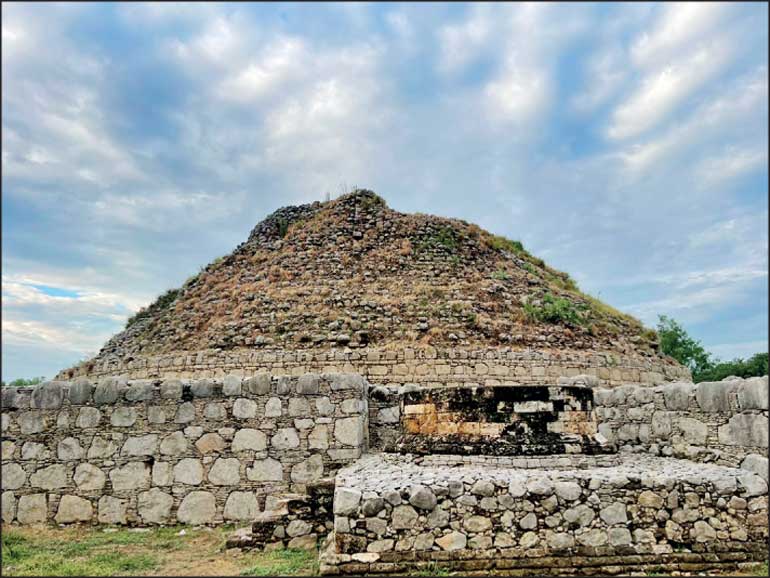
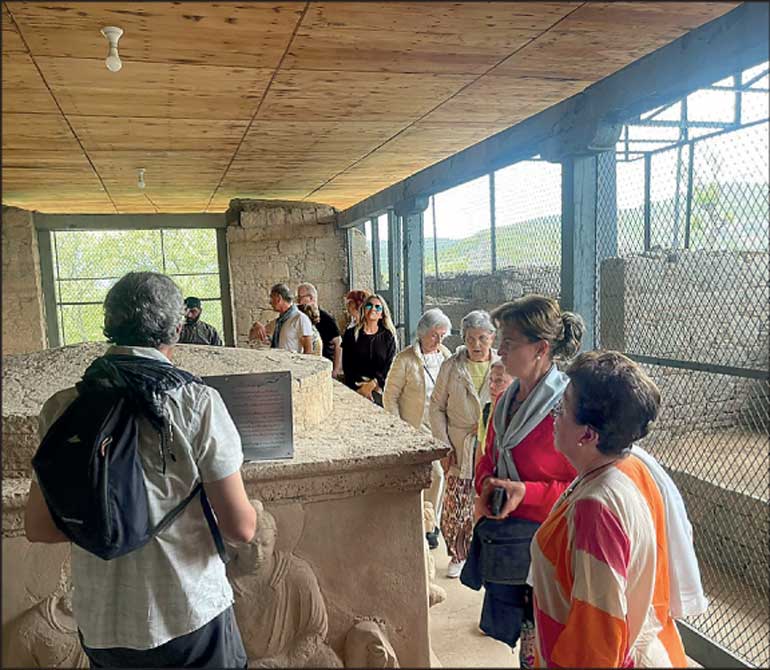
Foreign tourists at the Taxila Gandhara Buddhist sites
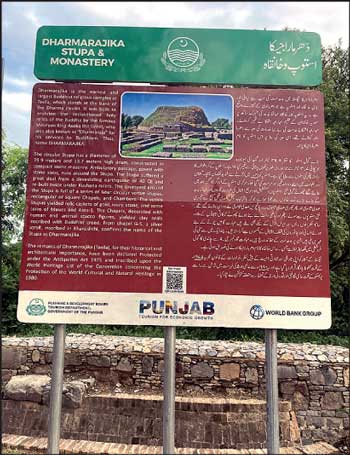 By the Harmony page team
By the Harmony page team
We are in Pakistan. It has been a drive of around one hour from Islamabad, the capital city. We head towards the Gandhara Buddhist heritage site of Taxila, a key diplomatic link this Islamic country has with nations such as Sri Lanka.
It had been raining the day before. The parched land has been waiting for this elixir. However, today has been humid and even at the late hour (5 p.m.) that we reach our destination, it is still somewhat warm. Yet, as our vehicle turns into a vicinity today known as Jaulian, the ancient seat of Buddhist saints in Taxila, the air is palpably serene, with more greenery, solitude and calm.
We pass small shops selling artefacts and souvenirs. In this visit we just want to get an overall feel of civilian life within the premises of Taxila and revel in the sunset time serenity of the area.
At the wheel is Shahid Jamil Rana, who has been promoting the Buddhist heritage of Pakistan for years through his company Last Tribes Pakistan that is linked to the global travel firm, Last Places Travel based in Spain.
Shahid’s clientele is mostly Japanese and European. His focus from 2023 has been to work with Buddhist nations such as Sri Lanka and Thailand, a goal which recently brought him to Sri Lanka for discussions with some Buddhist clergy members.
“We are now going to meet a Pakistani who lives in solitude like a monk,” says Shahid with a smile and answering our questioning looks he clarifies; “He is an ordinary Muslim. A citizen of Pakistan. His home is Taxila. He has lived here with these ancient monastic ruins around him for well over 50 years. He runs a souvenir shop. He is preparing us tea with fresh buffalo milk.”
As the vehicle meanders through isolation and tranquillity, the turbulence of modernity is a soundless echo. We make several turns into roadways that are enfolded by pristine foliage. The winds and soil seem heavy with memory. We are around 300 feet above field level, surrounded by ruins of monasteries and stupas.
They represent the ancient spiritual heritage of around 1st to 5th centuries signifying the golden age of the spread of Buddhism in the world.
Taxila was for a time the capital city of ancient Gandhāra located on the outskirts of the eastern side of the Indus River shore and impacted over time by Persia, Greece and Central Asia.
A special feeling of peace
“Taxila was an important Buddhist centre of learning,” explains Shahid to whom this place is a sort of second home.
“I come here even when I have no tour,” he says with a smile.
“There is a special feeling of peace here,” he explains.
“I am a Muslim. Islam means peace. Buddhism is about peace. Buddhism gives choice of conduct where a person chooses, knowing the repercussions of each action,” explains Shahid.
Through the years of taking hundreds of tourists to Taxila he seems to have imbibed the basics of Buddhistic pragmatism.
Travelling at the slowest speed to enable experientiality of observation we finally end up at the souvenir shop of Raja Jabar.
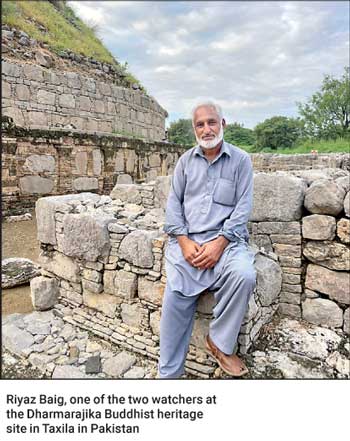 It is around here that ancient Buddhist monks who defined this place meditated and conducted their lives nourishing the achievement of nibbana; the soteriological goal in Buddhism, achieved with the extinguishing of all attachments and release from the cycle of rebirth (saṃsāra).
It is around here that ancient Buddhist monks who defined this place meditated and conducted their lives nourishing the achievement of nibbana; the soteriological goal in Buddhism, achieved with the extinguishing of all attachments and release from the cycle of rebirth (saṃsāra).
Raja Jabar has run this shop, a simple edifice for over four decades. There are beautifully carved mugs from semi-precious stones of different calibre, stone prayer beads as well as stone and cement carved miniature images of the Buddha.
We are enthralled by all the works of art displayed which are nominally priced. Our gaze however is preoccupied by the cement and stone carved Buddha statues.
Who creates these, we ask.
Raja Jabar explains that there are few families living in Taxila who have for years honed the skill of artistry, creating varied souvenirs for foreigners. Much of it are jewellery with semi-precious stones, especially those believed to have healing properties such as Lapiz Lazuli found in Pakistan and Afghanistan, he explains.
Soon we are served tea with the fresh buffalo milk and we watch the sun retreat for the night. The surrounding is as quiet as it would have been over 2,000 years ago when the Buddhist philosophy reigned in these locations. There are cemented stone steps over high and low incline where there once would have been none. Hundreds of robed figures would have walked barefoot over these same paths, treading on the cementless, cold earth. Fire lamps would have been lit for these monks to find their way about in the night. Frugal meals would have been cooked and consumed with awareness, not to mindlessly fill the body, but to sustain good health. Every single act would have been carried out with mindfulness and understanding that the human mind can be constrictive or destructive. In other words, that the human mind can be a battle ground where we are in power to decide how the victory unfolds.
Our reverie is interrupted by Jabar offering us a souvenir and asking us of we would like more tea.
His demeanour is that of a human being who has spent years nurturing reflection, simplicity and humility.
Who are the Buddhists who come here, we ask him.
“Many Buddhists arrive from different countries. Sri Lankan embassy staff comes here often as well. Many Buddhist enthusiasts who are from European countries are keen visitors to Taxila,” he explains.
His son, a youth in his twenties joins us. He has finished his higher studies and is helping his father improve his business.
Time has eluded us. The mask of darkness is upon the world. We bid our goodbyes and depart.
Dharmarajika stupa and monastery
We have made arrangements to return the following evening to the vicinity of the Dharmarajika stupa and monastery in Taxila, which is about 13 kilometres from where we are now.
Dharmarajika is a combination of the words Dharma which means righteousness and raja which means king or kingdom. Dharmarajika was envisaged as a kingdom of wisdom and righteousness by Ashoka, the last significant emperor of the Mauryan dynasty in India. Adopting Buddhism after achieving a bloody victory conquering the state of Kalinga *(modern day Odisha state) Ashoka had realised the futility of bloodshed and espoused non-violence, creating a governance structure of Buddhistic values.
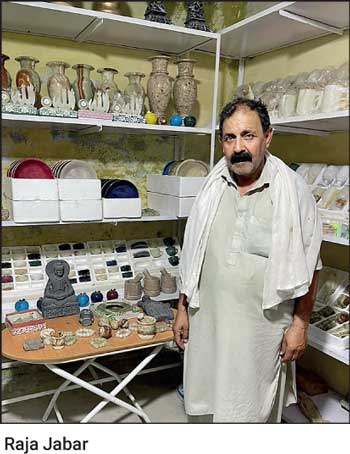 Basking in the travel memory of the previous day we proceed in rather humid weather once again to Taxila, this time to the territory where the Dharmarajika stupa and monastery is located.
Basking in the travel memory of the previous day we proceed in rather humid weather once again to Taxila, this time to the territory where the Dharmarajika stupa and monastery is located.
We reach around 4:30 p.m. and are greeted by Riyaz Baig. He is one of the watchmen employed by the Archaeology department. A resident of Taxila his home is in the outer periphery of the city. Here he lives in the Dharmarajika premises as part of his job to guard the place. He is daily surrounded by the ruins of the many meditation cells and larger monastery premises.
His demeanour is similar to Jabar and exudes a deep calm. His gaze is steadfast and gentle.
What does he know of Buddhism, we ask him.
“I only know that Lord Buddha was a peaceful person and that Buddhism teaches how to live a kind life,” he replies.
Shahid tries to tell us that these watchers and others here are Muslims and Pakistanis and therefore that they do not know much about Buddhism.
We stop him and state that what Riyaz knows is the crux of Buddhism, which in turn, can be explained as the core of any religion.
This article is the first of a series of writings on world spiritual heritage through travel where we will also participate in different religious ceremonies in the world, aimed at encouraging introspection and depth of thought.
We will continue our Taxila-Gandhara travel series in the upcoming editions, focusing on the intangible cultural heritage of Buddhist, and Islamic traditions and the wisdom enshrined therein.
Discover Kapruka, the leading online shopping platform in Sri Lanka, where you can conveniently send Gifts and Flowers to your loved ones for any event including Valentine ’s Day. Explore a wide range of popular Shopping Categories on Kapruka, including Toys, Groceries, Electronics, Birthday Cakes, Fruits, Chocolates, Flower Bouquets, Clothing, Watches, Lingerie, Gift Sets and Jewellery. Also if you’re interested in selling with Kapruka, Partner Central by Kapruka is the best solution to start with. Moreover, through Kapruka Global Shop, you can also enjoy the convenience of purchasing products from renowned platforms like Amazon and eBay and have them delivered to Sri Lanka.
Discover Kapruka, the leading online shopping platform in Sri Lanka, where you can conveniently send Gifts and Flowers to your loved ones for any event including Valentine ’s Day. Explore a wide range of popular Shopping Categories on Kapruka, including Toys, Groceries, Electronics, Birthday Cakes, Fruits, Chocolates, Flower Bouquets, Clothing, Watches, Lingerie, Gift Sets and Jewellery. Also if you’re interested in selling with Kapruka, Partner Central by Kapruka is the best solution to start with. Moreover, through Kapruka Global Shop, you can also enjoy the convenience of purchasing products from renowned platforms like Amazon and eBay and have them delivered to Sri Lanka.